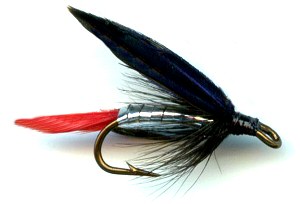The Butcher Double Hook Wet Fly
How did the Butcher wet fly pattern get its name? The Butcher wet fly is one of the classic flyfishing fly patterns. It was designed and constructed in the early 1800s and over the years has become a firm favourite and a good fish taker.

DOUBLE HOOKED TROUT AND SALMON FLIES USED IN THE FJORDS OF NORWAY. Hook size 10 12 14 - $US each
The Butcher Double Hook Wet Fly is shiny sleek and colourful, characteristics that epitomise a good wet fly. For some reason people think that this fly pattern is of Scottish origin. This is far from the truth. It is home is in a very ancient English spa town called Tunbridge Wells in the Kent countryside. The design of this fly seems to have been a joint invention by a Mr Dewhurst and a Mr Moon. The name Dewhurst in England was a famous brand of butchers. In this case it was in fact Mr Moon, who was the butcher. Was the fly named after Mr Moon's occupation? We do not know.
Some have suggested that the colours of the materials used for this fly represent the trade of being a butcher. The silver body stands for the butcher's knife. The dark blue wing are the colours of the stripes on the butchers white apron and the red tail stands for the meat. No one knows how this fly really got its name. There is even talk of it being initially called the Moon fly but later being changed to the Butcher fly. The theory I like the best is that it was named the "Butcher" because it caught so many fish. Butcher fishing flies that have the black original hackle fibers replaced with red ones are called Bloody Butcher flies.
Loch Assyant meets the Butcher
Many fishermen new to fly fishing seem to have little faith in the standard Butcher dressing. They add all sorts of extra material. Perhaps this is because they think of the pattern as a flashy attractor pattern and fish it on the point.
If they tried fishing it on the top dropper, they might change their minds. Whether it is taken as a beetle, swimming boatman or emerging midge is open to discussion, but I have found it deadly fished in that position.
Trout feeding in the scum lanes of a windswept Loch Assyant, (a freshwater loch in Sutherland, Scotland) came to it again and again last year. The measure of the greatness of this fly can be judged from the mount of variations it has spawned. The bloody butcher with its red hackle, a number of gold body Butchers have been sold and promoted. Hardy’s Gold Butcher being one of them. Then there is the Scottish and Irish kingfisher Butcher with either a blue or blae wing. These seem to work when the fish are feeding on olives.
The Butcher is often one of the flies that are relied upon to deliver results by competition fly fishermen. For me the choice is always the original in the top dropper position on a team of three flies for lake, loch, lough and reservoir trout fishing. Fished in the traditional way cast in front of a drifting bot for wild brown trout rather than stocked rainbow.
LINKEDIN COMMENT ON DOUBLE HOOKS
Bjorn has it right. The double hook stays tight to the fish's mouth without creating large holes that can be made by single hooks. The thick double hook is easy to remove with
sturdy pliers. Larger fish like those on the Cascapedia who fight for a longer period of time with appropriate tackle, don't have the large holes associated at times with single hooks.
Treble hooks are a problem all around. - Chris Travis

